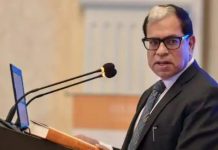
The arrest of the Indian gangster, Chhota Rajan alias Rajendra Sadashiv Nikalje, in Bali, Indonesia, led to rumours that he will help the investigators nab Dawood Ibrahim. Dawood, who is on the run since the Mumbai blasts in 1993, was branded a ‘global terrorist’ by the US in 2003. He is India’s ‘most-wanted’ man and currently lives in Pakistan. There is a feeling that once Rajan and Dawood are behind bars and awarded death sentences they will prove to be the third nail in the mafia-terrorism’s coffin.
For the Indian experts, including Ajit Doval, the National Security Advisor who has tracked — and almost killed — Dawood for decades, the end of Rajan and Dawood will indicate the birth of a new era in domestic terror. It will take out the two individuals, who ran sprawling underworld empires, and aided by foreign intelligence agencies, like Pakistan’s ISI, planned ghastly operations in India. It will, therefore, isolate the ISI and make it easier for New Delhi to pressurise Islamabad.
Unfortunately, the bitter truth is that Dawood and Rajan are not active participants in today’s global terror networks. Their heydays were over in the early 1990s. In the past three decades, Rajan’s empire was dismantled. Although Dawood’s loyalists like Chhota Shakeel are still in play, the former don is under ‘house arrest’ in Pakistan and has little to do with D-Company. Dawood converted his black money into legitimate assets in the West Asia in the 1990s and now leads a retired life. Thus, New Delhi can only earn a few brownie points from the arrests of Rajan and Dawood.
More importantly, the faces and operations of global terror have changed twice — once with the emergence of Osama bin Laden and al Qaeda in the 1990s and 2000s, and then with the recent rise and rise of the Islamic State (IS) in Syria and adjoining areas. The recent Paris attacks, which were along the lines of Mumbai’s 26/11 and claimed 129 lives, hinted that in the new scheme of things, the old guards, such as Rajan and Dawood, have become the relics of the past.
NEW FACES OF TERROR
Within a decade after 9/11, even bin Laden also lost his relevance. In his book, The Finish: The Killing of Osama bin Laden, Mark Bowden wrote, “Nine years after his most spectacular success, things were not going as Osama bin laden had foreseen. He was cut off from his followers, frustrated and his organisation was fraying. It (9/11) had instead set al Qaeda and himself on the run… The movement had been fragmented physically and conceptually. It had become less his organisation than a franchise, a banner waved by men who did not share his precise, divine insight, and who sullied its name with acts that killed, maimed and alienated those he sought to defend and convert.”
The same is true of Dawood. Reports indicate that he was no longer in charge of his empire. The ISI controlled his moves; he couldn’t travel outside his house without ISI’s approval. After Rajan’s arrest, a report in The Hindu hinted that Rajan was a ‘nobody’ in the global mafia or terror circles. “Of late, Rajan was known more for his bluster in media than anything else. Many observers had deduced that he had withdrawn into a post-crime life of peace somewhere in Australia,” said the article.
Rajan’s fall as a gangster-terrorist was possibly the reason why he gave in meekly. One theory is that there are strong links between Doval and Rajan. In 2005, Rajan’s aide, Vicky Malhotra, was intercepted in Delhi while travelling with Doval. According to The Hindu, the US embassy in New Delhi speculated that Doval was the conduit between India’s Intelligence Bureau (IB) and Malhotra to eliminate Dawood. (Rajan was earlier a loyalist of Dawood, but switched sides and possibly became an IB agent.) So, Operation ‘Rajan Arrest’ was masterminded by New Delhi to save the gangster, who killed many of Dawood’s henchmen and now faced a threat to his life from Dawood’s loyalists.
A corollary to this is that Rajan was deliberately provided a safe route to return to India through proper legal channels, as there was an Interpol’s red corner notice against him. The feeling in New Delhi was that Rajan’s purpose was served and there was no other help it could get from him. Therefore, it was an appropriate time to bring him back so that he could share all the relevant information about Dawood. This would help Doval and company to go after Pakistan, ISI and the Mumbai blasts’ mastermind.
Finally, it is believed that Rajan’s arrest was coincidental. First, Australia managed to identify him and alerted India. However, since Australia didn’t wish to get into the mess, India waited for Rajan to travel out of the country. In Bali, Rajan complicated the issue when he identified himself with his real name, Rajendra Nikalje, which helped Indonesia to arrest him. Once that happened, India had no choice but to ask for his deportation, especially since it knew Dawood was after Rajan.
In his seminal 2006 paper, David Kilcullen, who was the special advisor for counterinsurgency in the US, wrote, “Today’s insurgencies differ significantly… Insurgents may not be seeking to overthrow the state, may have no coherent strategy… There may be numerous competing insurgencies in one theatre, meaning that the counterinsurgent must control the overall environment rather than defeat a specific enemy. The actions of individuals (insurgents) and the propaganda effect of a subjective ‘single narrative’ may far outweigh practical progress… The economic relationship between insurgent and population may be diametrically opposed to classical theory.”
HOME-GROWN RADICALISM
The late 1980s witnessed the emergence of homegrown militancy in Kashmir. Local outfits challenged the might of the State and either asked for autonomy or a merger with Pakistan. As insurgency rose, ISI supported them. The democratic Assembly polls in Jammu & Kashmir in the mid-1990s dented the might of these local outfits as there was a call for peace. Since then, most terror attacks in Kashmir and elsewhere in India were masterminded by the ISI, and even carried out by Pakistani citizens. Mumbai’s 26/11 was a prime example.













